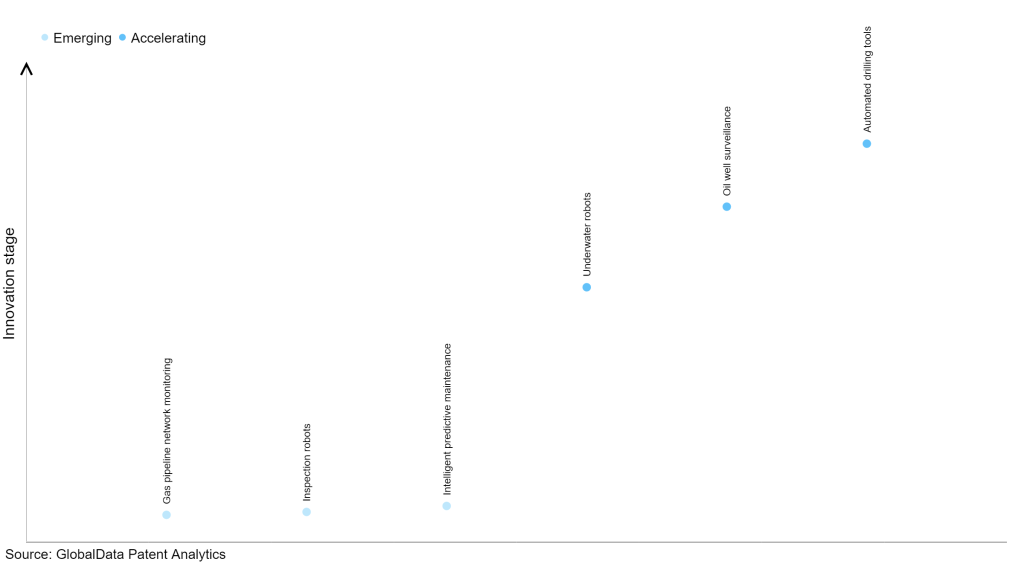The oil & gas industry continues to be a hotbed of patent innovation. Activity is driven by digitalization, analytics, and cybersecurity, and growing importance of technologies such as predictive maintenance, robotics and drones. In the last three years alone, there have been over 327,000 patents filed and granted in the oil & gas industry, according to GlobalData’s report on Internet of Things in oil & gas: gas pipeline network monitoring. Buy the report here.
However, not all innovations are equal and nor do they follow a constant upward trend. Instead, their evolution takes the form of an S-shaped curve that reflects their typical lifecycle from early emergence to accelerating adoption, before finally stabilizing and reaching maturity.
Identifying where a particular innovation is on this journey, especially those that are in the emerging and accelerating stages, is essential for understanding their current level of adoption and the likely future trajectory and impact they will have.
65+ innovations will shape the oil & gas industry
According to GlobalData’s Technology Foresights, which plots the S-curve for the oil & gas industry using innovation intensity models built on over 201,000 patents, there are 65+ innovation areas that will shape the future of the industry.
Within the emerging innovation stage, gas pipeline network monitoring, inspection robots and intelligent predictive maintenance are disruptive technologies that are in the early stages of application and should be tracked closely. Underwater robots, oil well surveillance and automated drilling tools are some of the accelerating innovation areas, where adoption has been steadily increasing.
Innovation S-curve for Internet of Things in the oil & gas industry

Gas pipeline network monitoring is a key innovation area in Internet of Things
Gas pipeline network monitoring entails monitoring and managing the various components of a gas pipeline network to ensure safe and efficient operation. It includes monitoring gas storage tanks, pipelines and equipment, as well as tracking gas consumption and implementing appropriate safety measures.
GlobalData’s analysis also uncovers the companies at the forefront of each innovation area and assesses the potential reach and impact of their patenting activity across different applications and geographies. According to GlobalData, there are 140 companies, spanning technology vendors, established oil & gas companies, and up-and-coming start-ups engaged in the development and application of gas pipeline network monitoring.
Key players in gas pipeline network monitoring – a disruptive innovation in the oil & gas industry
‘Application diversity’ measures the number of applications identified for each patent. It broadly splits companies into either ‘niche’ or ‘diversified’ innovators.
‘Geographic reach’ refers to the number of countries each patent is registered in. It reflects the breadth of geographic application intended, ranging from ‘global’ to ‘local’.
Patent volumes related to gas pipeline network monitoring
Source: GlobalData Patent Analytics
Air products and Chemicals is one of the lading patent filers in the gas pipeline network monitoring for the oil & gas industry. It is one of the largest industrial gas suppliers in the world. It also operates pipeline systems located around the world in major industrial locations, where it supplies industrial gases. It has developed a process monitoring and control system to maintain the integrity of its infrastructure. Some other key patent filers in the space include Air Liquide, Toyota Motor, and China Petrochemical.
Air Liquide, Air Products and Chemicals and Arkema are among the leaders in terms of application diversity. The French chemicals company, Arkema, primarily manufacturers specialty materials for industrial applications.
By means of geographic reach, Kobe Steel of Japan held the top position, followed by SiGNa Chemistry and Hexagon Composites. Kobe Steel is primarily a steel manufacturer, which caters to the oil & gas industry through its product portfolio including material for gas pipelines and compressor equipment, and also offers engineering services.
Gas pipeline network monitoring is a critical element in stages of gas processing and liquefaction, as well as last mile distribution of natural gas to the customers. It helps regulate gas flow rates as well as detect leakges.
To further understand the key themes and technologies disrupting the oil & gas industry, access GlobalData’s latest thematic research report on Internet of Things in Oil & Gas.
Data Insights
From

The gold standard of business intelligence.
Blending expert knowledge with cutting-edge technology, GlobalData’s unrivalled proprietary data will enable you to decode what’s happening in your market. You can make better informed decisions and gain a future-proof advantage over your competitors.



